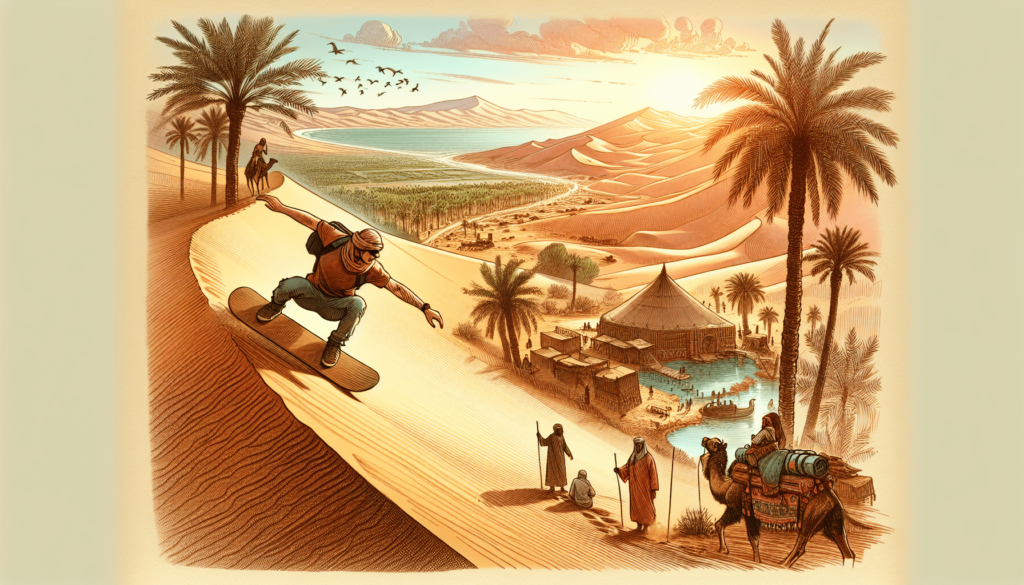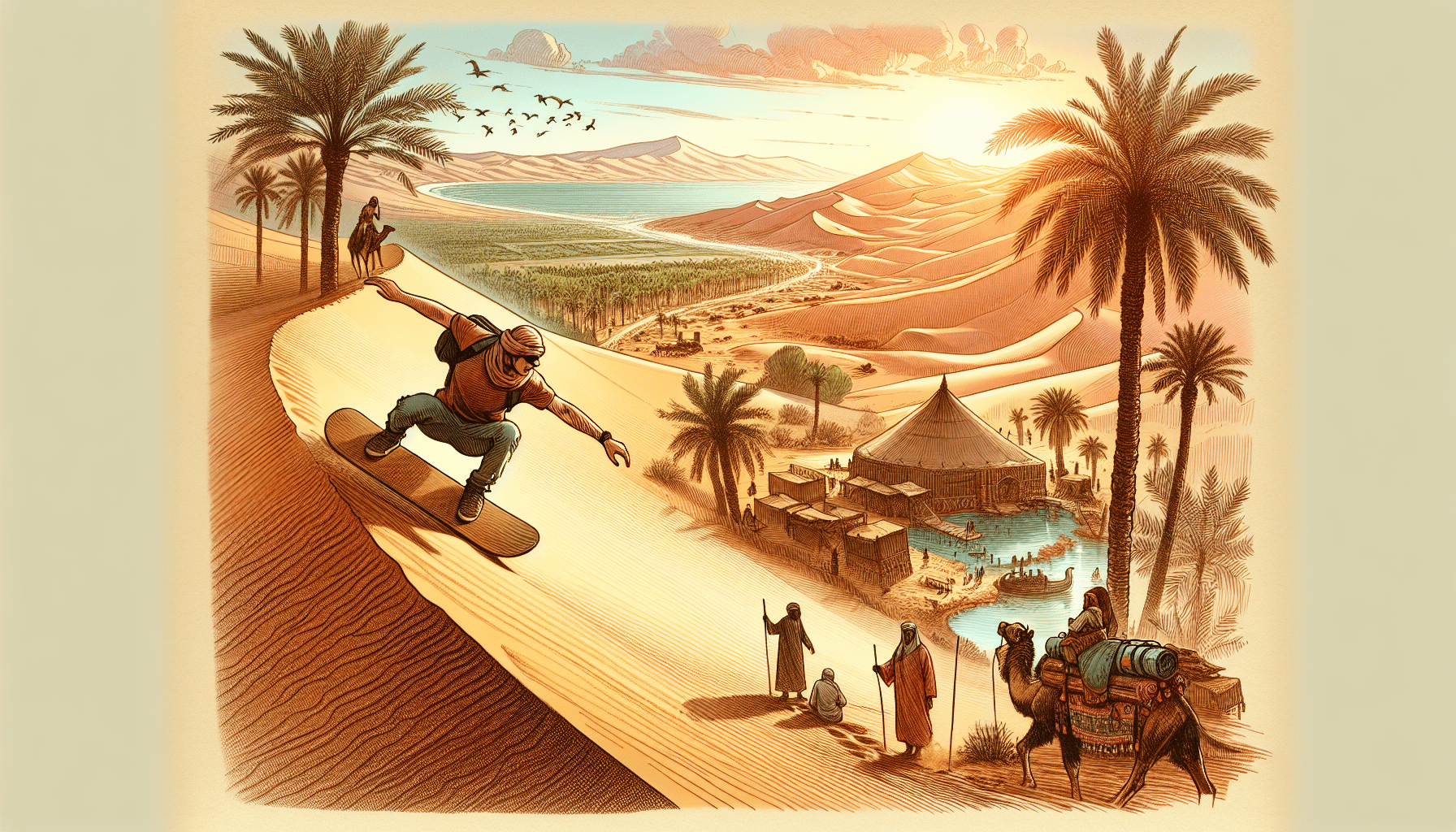Imagine yourself gliding down the massive sand dunes of the legendary Sahara Desert, feeling the rush of adrenaline as the warm desert wind whips through your hair. In this article, we will take you on an incredible adventure as we explore the thrilling sport of sandboarding in the enchanting Sahara Desert. Get ready to experience the thrill of carving through the golden sand, dune after dune, and immerse yourself in the breathtaking beauty of one of the world’s most iconic landscapes. So grab your board and get ready for an unforgettable adventure in the heart of the desert.
1. About Sandboarding
– What is sandboarding?
Sandboarding is an exhilarating sport that involves riding down steep sand dunes on a specially designed board. It is often compared to snowboarding because of the similar techniques used, but instead of sliding down snowy slopes, sandboarders glide down the sandy hills of deserts or coastal areas.
– History of sandboarding
While the exact origins of sandboarding are unclear, it is believed to have originated in ancient Egypt, where it was practiced by the pharaohs and their entourages. Evidence of sandboarding can be seen in ancient hieroglyphs, where pharaohs are depicted sliding down sand dunes on boards.
Sandboarding gained popularity in the late 20th century as explorers and adventure enthusiasts discovered the thrill of gliding down sandy slopes. Today, it has become a popular activity in various desert regions around the world.
– Differences between sandboarding and snowboarding
While sandboarding and snowboarding share similarities in terms of technique, there are some key differences between the two sports.
The primary difference is, of course, the surface on which they are practiced. Snowboarding takes place on snow-covered slopes, while sandboarding is done on sand dunes. The texture and consistency of the surfaces also differ, with sand providing a softer landing compared to snow.
Additionally, sandboards are specifically designed for sandboarding, featuring a waxed base and unique bindings that allow for easy maneuvering on loose sand. Snowboards, on the other hand, have a different design optimized for gliding on snow.
2. The Sahara Desert
– Introduction to the Sahara
The Sahara Desert is the largest hot desert in the world, spanning over 9 million square kilometers across North Africa. It is a vast desert landscape known for its golden sand dunes, extreme temperatures, and unique natural beauty. The Sahara is home to diverse flora and fauna, as well as rich cultural heritage.
– Geographical features
The Sahara Desert is characterized by its expansive sand dunes, which can reach heights of up to 180 meters. These dunes are constantly shifting due to the movement of the desert winds, creating an ever-changing landscape.
In addition to the dunes, the Sahara also features rocky plateaus, gravel plains, and dry riverbeds known as wadis. The desert is also home to several mountain ranges, including the Atlas Mountains, which provide a stunning backdrop to the sandy dunes.
– Climate and weather
The Sahara Desert is known for its extreme climate. It experiences scorching hot temperatures during the day, often exceeding 40 degrees Celsius, while nights are considerably cooler. The lack of rainfall in the region makes the Sahara one of the driest places on Earth.
The weather in the Sahara can be unpredictable, with strong winds and sandstorms occasionally sweeping through the desert. It is important to plan your sandboarding adventure accordingly and take necessary precautions to ensure your safety.

3. Sandboarding in the Sahara
– Unique experience
Sandboarding in the Sahara offers a truly unique and thrilling experience. The vast expanse of golden sand dunes and the breathtaking views make for an unforgettable adventure. The sensation of gliding down the slopes, feeling the wind in your hair, and the warm sand beneath your feet is unlike any other.
– Skill requirements
Sandboarding can be enjoyed by people of different skill levels. Whether you are a beginner or an experienced boarder, there are slopes suitable for everyone. However, it is recommended to have some prior experience with board sports as it can help you adapt to the techniques required for sandboarding.
– Safety precautions
While sandboarding is a thrilling activity, it is important to prioritize safety. Always wear proper protective gear, including a helmet, elbow and knee pads to prevent injuries in case of falls. It is also crucial to stay hydrated and wear sunscreen to protect your skin from the intense desert sun.
4. Equipment for Sandboarding
– Sandboard
The most essential piece of equipment for sandboarding is, of course, the sandboard itself. Sandboards are specifically designed for gliding on sand and typically have a waxed base to reduce friction and increase speed. They come in various shapes and sizes, depending on the rider’s preferences and skill level.
– Protective gear
To ensure your safety while sandboarding, it is essential to wear proper protective gear. This includes a helmet, elbow and knee pads, and wrist guards. These protective measures can significantly reduce the risk of injuries in case of falls or accidents.
– Proper attire
When sandboarding in the Sahara, it is important to dress appropriately for the desert environment. Lightweight and breathable clothing that covers your skin is recommended to protect yourself from the harsh sun and sand. It is also advisable to wear closed-toe shoes to prevent sand from getting into your footwear.

5. Finding a Sandboarding Tour
– Researching reputable tour companies
When planning your sandboarding adventure in the Sahara, it is crucial to research and choose a reputable tour company. Look for companies with positive reviews and a good track record of providing safe and enjoyable experiences for their customers.
– Reading reviews and testimonials
Reading reviews and testimonials from previous travelers who have participated in sandboarding tours can provide valuable insights into the quality of the experience offered by different tour companies. Look for reviews that mention safety measures, professionalism of guides, and overall customer satisfaction.
– Booking in advance
Sandboarding tours in the Sahara are popular, especially during peak travel seasons. It is advisable to book your tour in advance to secure your spot and avoid any last-minute disappointments. Planning ahead also gives you the flexibility to choose the dates that work best for you.
6. Getting to the Sahara
– Transportation options
Getting to the Sahara can involve different transportation options, depending on your location and preferences. If you are traveling internationally, you can fly into major cities in North Africa and then take domestic flights or overland transportation to reach the desert region.
Alternatively, you can also opt for organized tours that include transportation from major cities to the Sahara. These tours often provide comfortable vehicles and knowledgeable guides to ensure a smooth and hassle-free journey.
– Visa requirements
Before traveling to the Sahara, it is important to check the visa requirements of the country you will be entering. Different countries in North Africa have varying visa policies, and it is necessary to obtain the appropriate visas before your trip.
– Considerations for international travelers
International travelers planning a sandboarding adventure in the Sahara should also consider factors such as currency exchange, travel insurance, and any necessary vaccinations or health precautions. It is advisable to consult with a travel agent or research the specific requirements and recommendations for the countries you will be visiting.
7. Accommodation in the Sahara
– Desert camps
Accommodation options in the Sahara often include desert camps, which provide a unique and immersive experience. These camps are typically located near the sand dunes and offer traditional Berber-style tents or luxurious desert lodges. Staying in a desert camp allows you to fully experience the serenity and beauty of the Sahara.
– Tents and sleeping arrangements
Most desert camps provide comfortable tents with basic amenities such as beds, bedding, and sometimes even private bathrooms. While the accommodations may not be as luxurious as hotels, they offer a unique and authentic desert experience.
– Amenities and facilities
Desert camps usually offer communal areas where travelers can relax, socialize, and enjoy traditional meals. Some camps may also have additional facilities such as swimming pools, spa services, or cultural performances. However, it is important to note that the amenities available can vary depending on the type and location of the camp.
8. Planning Your Sandboarding Adventure
– Choosing the right time to visit
When planning your sandboarding adventure in the Sahara, it is important to choose the right time to visit. The desert can experience extreme temperatures, so it is advisable to avoid the hottest months and visit during spring or fall when the weather is more moderate.
– Duration of the trip
The duration of your sandboarding adventure can vary depending on your preferences and availability. Some travelers opt for a short desert excursion of a few days, while others choose longer trips to fully immerse themselves in the desert environment. Consider your schedule and desired level of exploration when planning the duration of your trip.
– Itinerary and activities
While sandboarding may be the main highlight of your Sahara adventure, there are also other activities and attractions to consider. From camel treks to exploring ancient ruins, the Sahara offers a range of experiences. Plan your itinerary to include these additional activities and make the most of your time in the desert.
9. Tips for Sandboarding in the Sahara
– Mastering sandboarding techniques
Sandboarding requires some specific techniques that differ from snowboarding. To make the most of your sandboarding experience, take the time to learn and practice the proper techniques, such as shifting your weight and controlling your speed. Consider taking a lesson or hiring a guide who can provide instruction and helpful tips.
– Staying hydrated in the desert
The Sahara’s extreme climate can quickly lead to dehydration. It is crucial to drink plenty of water and stay hydrated throughout your sandboarding adventure. Carry a refillable water bottle and remember to drink regularly, even if you don’t feel thirsty. It is also wise to avoid excessive consumption of alcohol and caffeine as they can contribute to dehydration.
– Protecting yourself from the sun
The desert sun can be intense, and it is essential to protect yourself from harmful UV rays. Wear a wide-brimmed hat, sunglasses, and apply sunscreen with a high SPF. Consider wearing lightweight, light-colored clothing that covers your skin to prevent sunburn and heat-related illnesses.
10. Conclusion
– Experiencing the thrill of sandboarding in the Sahara
Sandboarding in the Sahara Desert offers a thrilling and unique adventure. The vast golden dunes, the adrenaline rush of gliding down the slopes, and the breathtaking scenery make for an unforgettable experience.
– Creating lifelong memories
Sandboarding in the Sahara is not just an activity; it is an opportunity to create lasting memories. The combination of the surreal desert landscape, the exhilaration of the sport, and the cultural richness of the region will leave you with memories that will stay with you forever.
– Exploring other adventures in the desert
Beyond sandboarding, the Sahara offers a plethora of other exciting adventures. From camel trekking to hiking in the Atlas Mountains, there are numerous opportunities to explore the diverse landscapes and rich cultural heritage of the desert.
Embark on a sandboarding adventure in the Sahara, and let the magic of the golden dunes and the boundless beauty of the desert captivate your senses. Get ready for an experience of a lifetime, filled with adrenaline, serenity, and endless possibilities.

